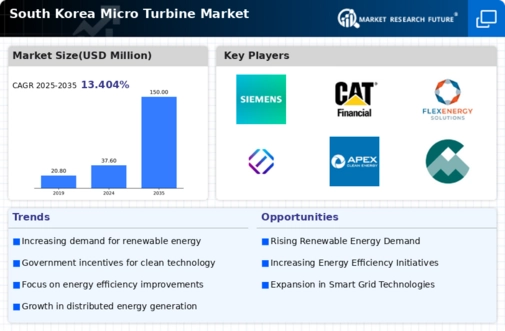Rising Energy Demand
The micro turbine market in South Korea is experiencing growth due to the increasing demand for energy. As urbanization and industrialization continue to rise, the need for reliable and efficient energy sources becomes paramount. The country's energy consumption has been projected to grow by approximately 2.5% annually, leading to a greater interest in alternative energy solutions. Micro turbines, known for their ability to generate power from various fuels, are becoming a viable option for meeting this demand. This trend is further supported by the government's push for energy diversification, which encourages the adoption of micro turbine technology. As a result, the micro turbine market is likely to expand, driven by the necessity for sustainable energy solutions that can cater to the growing population and industrial needs.
Environmental Regulations
In South Korea, stringent environmental regulations are shaping the micro turbine market. The government has implemented policies aimed at reducing greenhouse gas emissions and promoting cleaner energy sources. These regulations create a favorable environment for micro turbines, which produce lower emissions compared to traditional fossil fuel-based power generation. The South Korean government aims to reduce its carbon footprint by 37% by 2030, which aligns with the capabilities of micro turbines. As industries seek to comply with these regulations, the demand for micro turbines is expected to rise. This regulatory landscape not only encourages innovation in the micro turbine market but also positions it as a key player in the transition towards a more sustainable energy future.
Technological Innovations
Technological advancements are playing a crucial role in the evolution of the micro turbine market in South Korea. Innovations in turbine design, materials, and control systems are enhancing the efficiency and reliability of micro turbines. For instance, the integration of digital technologies and IoT capabilities allows for real-time monitoring and optimization of energy production. This is particularly relevant in a country that prioritizes smart city initiatives and energy efficiency. The micro turbine market is likely to benefit from these innovations, as they not only improve performance but also reduce operational costs. As technology continues to advance, the micro turbine market may see increased adoption across various sectors, including residential, commercial, and industrial applications.
Energy Independence Initiatives
Initiatives aimed at achieving energy independence are propelling the micro turbine market in South Korea. The country has historically relied on imported fossil fuels, which poses risks to energy security. In response, the government is promoting the use of renewable energy sources, including micro turbines, to diversify its energy portfolio. By investing in local energy generation, South Korea aims to reduce its dependence on foreign energy supplies. This shift is expected to create a robust market for micro turbines, as they offer a decentralized solution that can be deployed in various settings. The potential for energy independence is likely to drive further investments in the micro turbine market, fostering innovation and growth.
Cost-Effectiveness of Micro Turbines
The economic viability of micro turbines is becoming increasingly apparent in South Korea, contributing to the growth of this sector. As the cost of renewable energy technologies continues to decline, micro turbines are emerging as a cost-effective solution for energy generation. The levelized cost of electricity (LCOE) for micro turbines has decreased significantly, making them competitive with traditional energy sources. This trend is particularly appealing for businesses and industries looking to reduce energy expenses. Furthermore, the potential for government subsidies and incentives enhances the attractiveness of investing in micro turbines. As organizations seek to optimize their energy costs, the micro turbine market is likely to see a surge in demand, driven by the economic benefits associated with this technology.


















Leave a Comment